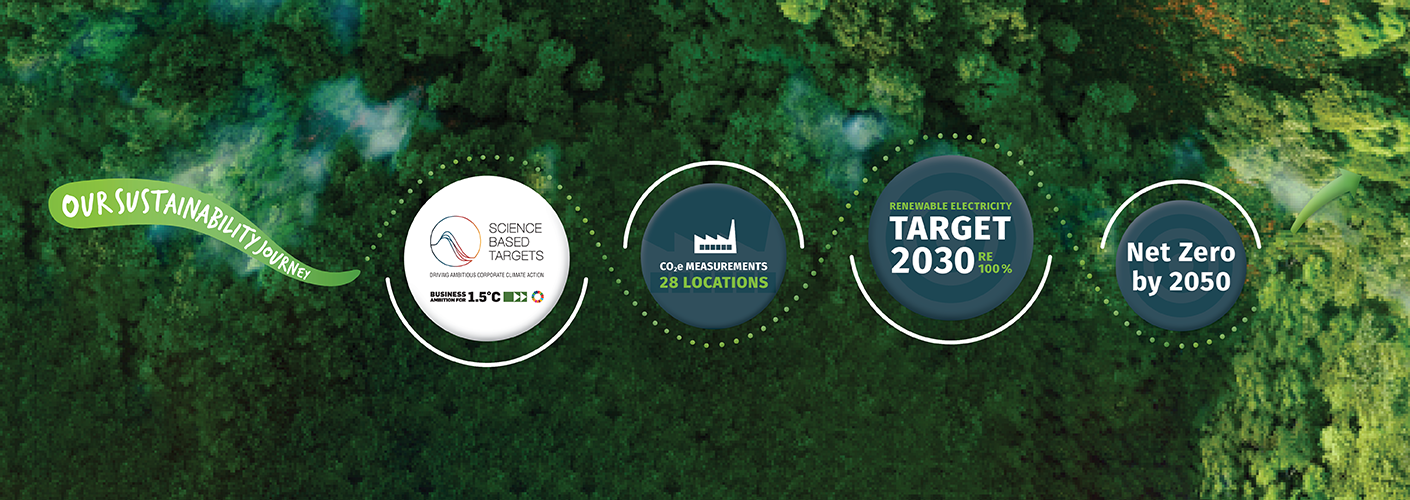Our Sustainability Journey
As a global supplier of animal raw materials and ingredients, the BHJ group is deeply committed to conducting business in an environmentally responsible manner. The latest climate science from the Intergovernmental Panel on Climate Change (IPCC) indicates that it is still possible to limit global temperature rise to 1.5°C. However, achieving this goal requires rapid and substantial reductions in greenhouse gas (GHG) emissions. To succeed, global emissions must be halved before 2030 and reach net-zero by 2050.

In response to this urgent call to action, we are pleased to announce that our near-term, long-term and FLAG[1] (Forest, Land, and Agriculture) science-based targets were officially validated and approved by the Science Based Targets initiative[2] (SBTi) on December 19, 2024. This validation confirms that our climate goals meet the SBTi’s Corporate Net-Zero Standard Criteria[3], reaffirming our commitment to a net-zero future. Our goal is to reach net-zero emissions across the value chain by 2050. To achieve this, we plan to reduce absolute GHG emissions across our value chain by 90% and FLAG GHG emissions by 72% by 2050, based on a 2021 baseline.
Our near-term targets (2030):
- BHJ commits to reduce absolute scope 1 and 2 GHG emissions 48.8% by 2030 from a 2021 base year.[4] BHJ also commits that 80% of its suppliers by emissions covering upstream transportation and distribution, will have science-based targets[5] by 2028. BHJ further commits that 80% of its customers by emissions covering downstream transportation and distribution and processing of sold products will have science-based targets[6] by 2028.
- BHJ commits to reduce scope 3 FLAG GHG emissions 30.3% by 2030 from a 2021 base year.[7] BHJ also commits to no deforestation across its primary deforestation-linked commodities, with a target date of December 31, 2025.
Our long-term targets (2050):
- BHJ commits to reduce absolute scope 1 and 2 GHG emissions 90% by 2050 from a 2021 base year.[8] BHJ also commits to reduce absolute scope 3 GHG emissions 90% by 2050 from a 2021 base year.
- BHJ commits to reduce scope 3 FLAG GHG emissions by 72% by 2050 from a base year 2021.[9]
Achieving our 2030 targets
As part of our journey toward achieving net-zero emissions across our value chain by 2050, we have set near-term goals for 2030. These commitments are vital steps in driving change and fostering decarbonization across our supply chain. To achieve our near-term goals, we have developed an actionable strategy that covers scope 1, 2 and 3 emissions. Scope 1 covers direct emissions from our operations, scope 2 relate to emissions from purchased energy and scope 3 includes all other indirect emissions in our supply chain.[10] This strategy focusses on optimizing our operations, leveraging clean technology and working closely with our partners. By setting measurable milestones and continuously assessing our progress, we ensure that each step brings us closer to a better tomorrow.
Transitioning to 100% renewable electricity
Reducing our direct emissions is a top priority and directly supports our 2030 goal of reducing absolute scope 1 and 2 GHG emissions by 48.8%. By 2030, we aim to use 100% renewable electricity across all company locations, including offices and production facilities. Our strategy includes:
- Enhancing energy efficiency across our sites to lower overall consumption.
- Phasing out non-renewable energy sources to ensure a clean energy supply.
- Investing in renewable energy technologies, such as solar and wind power, while sourcing renewable electricity from external providers.
Cutting transport emissions by 30% from a 2021 base year
Transportation and logistics account for approximately 40% of our total supply chain emissions, making it a critical focus area in achieving our 2030 goals, particularly in reducing scope 3 emissions. To address this challenge, we are committed to reducing transport emissions by 3% annually, reaching a 30% reduction by 2030. Our strategy includes:
- Enhancing data collection to better understand and reduce transport emissions.
- Exploring sustainable transport solutions, such as electric vehicles and alternative fuels, in partnership with logistics providers.
- Optimizing supply chain logistics, including improving warehouse energy efficiency and transitioning to renewable electricity.
Partnering with suppliers and customers to lower raw material emissions
Raw materials contribute significantly to our scope 3 emissions, which is why this initiative is essential for achieving our 30.3% FLAG reduction target and ensuring that 80% of our suppliers and customers respectively set science-based targets by 2028. To cut these emissions by 30.3% by 2030, our strategy includes:
- Partnering with suppliers who share our sustainability ambitions.
- Collecting primary data from our supply chain to measure and track emissions, enabling both our partners and us to develop solutions that reduce emissions.
- Supporting projects and initiatives within to our supply chain, such as:
- Regenerative agriculture projects to improve carbon sequestration and enhance environmental resilience.
- Implementing sustainable sourcing practices to ensure no deforestation across our deforestation-linked commodities.
For further inquiries, please do not hesitate to contact:
[1] For more information about the SBTi Forest, Land and Agriculture Guidance, please see: https://sciencebasedtargets.org/sectors/forest-land-and-agriculture.
[2] The Science Based Targets initiative (SBTi) is a global initiative that helps companies set emissions reduction targets in line with the latest climate science to limit global warming. For more information about the SBTi, please see: https://sciencebasedtargets.org/.
[3] For more information about the SBTI Corporate Net-Zero Standard Criteria, please see: https://sciencebasedtargets.org/net-zero.
[4] The target boundary includes land-related emissions and removals from bioenergy feedstocks.
[5] Having science-based targets does not necessarily mean that suppliers are required to join the Science Based Targets initiative.
[6] Having science-based targets does not necessarily mean that customers are required to join the Science Based Targets initiative.
[7] Target includes FLAG emissions and removals.
[8] The target boundary includes land-related emissions and removals from bioenergy feedstocks.
[9] Targets includes FLAG emissions and removals.
[10] Source: Greenhouse Gas Protocol Initiative. Greenhouse Gas Protocol: A Corporate Accounting and Reporting Standard (Revised Edition). World Resources Institute, 2004.


